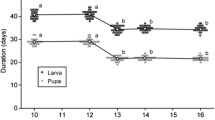Abstract
The effect of temperature, humidity and photoperiod on the development of Neozygites cf. floridana (Weiser and Muma) in the cassava green mite, Mononychellus tanajoa (Bondar) was studied in the laboratory. Dead infected mites began to appear 2.5 days after inoculation. At 33 and 28°C peak mortalities were higher and occurred earlier (after 2.5 days), than at 23 and 18°C. Mean LT50 (time for half the infected mites to die) decreased with increasing temperature as follows: 3.9, 3.0, 2.9 and 2.5 days at 18, 23, 28 and 33°C, respectively. When placed under conditions of high relative humidity for a period of 24 h, the percentage of dead infected mites from which the fungus sporulated was highest at 28°C (51.4%) and lowest at 33°C (6.5%). The development of the fungus inside the mite was not significantly affected by ambient humidity or photoperiod. No significant interactions between tested factors were found.
Similar content being viewed by others
References
Abbott W.S. 1925. A method of computing the effectiveness of an insecticide. J. Econ. Entomol. 18: 265–267.
Agudelo-Silva P. 1986. A species of Triplosporium (Zygomycetes: Entomophthoraceae) infecting Mononychellus progresivus (Acari: Tetranychidae) in Venezuela. Fla. Entomol. 69 (2): 444–446.
Anderson D. B. 1936. Relative humidity or vapour pressure deficit. Ecology 17: 277–282.
Benz G. 1987. Environment. In Epizootiology of insect diseases, J.R. Fuxa and Y. Tanada (eds), pp. 177–214 John Wiley & Sons, New York.
Brandenburg R.L. and Kennedy G.G. 1982. Relationship of Neozygites floridana (Entomophthorales: Entomophthoraceae) to the two-spotted spider mite (Acari: Tetranychidae) in field corn. J. Econ. Entomol. 75: 691–694.
Carner G.R. 1976. A description of the life cycle of Entomophthora sp. in the two-spotted spider mite. J. Invertebr. Pathol. 28: 245–254.
Carner G.R. and Canerday T.D. 1968. Field and laboratory investigations with Entomophthora fresenii, a pathogen of Tetranychus spp. J. Econ. Entomol. 61(4): 956–959.
Carruthers R.I., Larkin T.S. and Firstencel H. 1992. Influence of thermal ecology on the mycosis of a rangeland grasshopper. Ecology 73: 190–204.
Delalibera I., Sosa Gomes D.R., de Moraes G.J., de Alencar J.A. and Farias Araujo W. 1992. Infection of Mononychellus tanajoa (Acari: Tetranychidae) by the fungus Neozygites sp. (Entomophthorales) in northeastern Brazil. Fla Entomol. 75(1): 145–147.
Eilenberg J. 1987. The culture of Entomophthora muscae (C) Fres. (Zygomycetes: Entomophthoraceae) in the carrot flies (Psila rosae F.) (Diptera: Psilidae) and the effect of temperature on the pathology of the fungus. Entomophaga 32: 425–435.
Ferro D. N. and Chapman R. B. 1979. Effects of different constant humidities and temperatures on the two spotted spider mite egg hatch. Environ. Entomol. 8: 701–705.
Humber R.A., Moraes G.J. and dos Santos J.M. 1981. Natural infection of Tetranychus evansi (Acari: Tetranychidae) by a Triplosporium sp. (Zygomycetes: Entomophthoraceae) in N.E. Brazil. Entomophaga 26: 421–425.
Kenneth R.G., Wallis G., Gerson U. and Plaut H.N. 1972. Observations and experiments on Triplosporium floridanum attacking spider mites in Israel. J. Inverteb. Pathol. 19: 366–369.
Klubertanz T.H., Pedigo L.R. and Carlson R.E. 1991. Impact of fungal epizootics on the biology and management of the twospotted spider mite (Acari: Tetranychidae) in soybean. Environ. Entomol. 20(2): 731–735.
Mietkiewski R., Balazy S. and van der Geest L.P.S. 1993. Observations on a mycosis of spider mites (Acari: Tetranychidae) caused by Neozygites floridana in Poland. J. Invert. Pathol. 61: 317–319.
Milner R.J. and Bourne J. 1983. Influence of temperature and leaf wetness on the infection of Acyrthosiphon kondoi with Erynia neoaphidis. Ann. Appl. Biol. 102: 19–27.
Milner R.J. and Lutton G.G. 1983. Effect of temperature on Zoophthora radicans (Brefeld) Batko an introduced microbial control agent of the spotted alfalfa aphid, Therioaphis trifolli (Monell) f. maculata. J. Aust. Entomol. Soc. 22: 167–173.
Nemoto H. and Aoki J. 1975. Entomophthora floridana (Entomophthorales: Entomphthoraceae) attacking the sugi spider mite, Oligonychus hondoensis (Acari: Tetranychidae) in Japan. Appl. Entomol. Zool. 10: 90–95.
SAS Institute, Inc. 1988. SAS/STATTM User's Guide. Release 6.03, ed. SAS Institute, Cary, N.C., 1028 pp.
Selhime A.G. and Muma M.H. 1966. Biology of Entomophthora floridana attacking Eutetranychus banksi. Fla. Entomol. 49: 161–168.
Smitley D.R., Brooks W.M. and Kennedy G.G. 1986. Environmental effects on the production of primary and secondary conidia, infection and pathogenicity of Neozygites floridana, a pathogen of the two spotted spider mite, Tetranychus urticae. J. Inverteb. Pathol. 47: 325–332.
Solomon M.E. 1951. Control of humidity with potassium hydroxide, sulphuric acid and other solutions. Bull. Entomol. Res. 42: 543–553.
Stevens N.E. 1916. A method of studying the humidity relations of fungi in culture. Phytopathology 16: 428–432.
Stimmann M.W. 1968. Effect of temperature on infection of the garden sympylan by Entomphthora coronata. J. Econ. Entomol. 61(6): 1558–1560.
Tillotson D.K., Margolies D.C. and Nechols J.R. 1990. Effect of temperature and photoperiod on mortality of Melanoplus differentialis (Orthoptera: Acrididae) infected by Entomophaga grylli Pathotype 2 (Entomophthorales: Entomophthoraceae). J. Kansas. Entomol. Soc. 63(2): 252–259.
Watson D.W., Mullens B.A. and Petersen J.J. 1993. Behavioural fever response of Musca domestica (Diptera: Muscidae) to infection by Entomophthora muscae (Zygomycetes: Entomophthorales). J. Inverteb. Pathol. 61: 10–16.
Weiser J. and Muma M.H. 1966. Entomophthora floridana n. sp. (Phycomycetes: Entomophthoraceae), a parasite of the Texas citrus mite, Eutetranychus banksi. Fla. Entomol. 49: 155–159.
Wilding, N. 1970. The effect of temperature on the infectivity and incubation periods of the fungi Entomophthora aphidis and E. thaxteriana for the pea aphid Acyrthosiphon pisum. Proc. Int. Coll. Insect. Pathol. College Park, M D., pp. 84–88.
Author information
Authors and Affiliations
Rights and permissions
About this article
Cite this article
Oduor, G.I., de Moraes, G.J., Yaninek, J.S. et al. Effect of temperature, humidity and photoperiod on mortality of Mononychellus tanajoa (Acari: Tetranychidae) infected by Neozygites cf. floridana (Zygomycetes: Entomophthorales). Exp Appl Acarol 19, 571–579 (1995). https://doi.org/10.1007/BF00048812
Issue Date:
DOI: https://doi.org/10.1007/BF00048812




